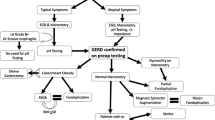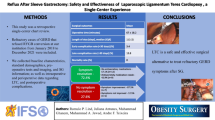Abstract
Purpose
This article describes the surgical techniques to prevent reflux esophagitis (RE) after proximal gastrectomy reconstructed by esophagogastrostomy (PGE) preservation of the lower esophageal sphincter (LES) and both pyloric and celiac branches of the vagal nerve (PCVN), and reconstruction of the new His angle (HA) for early proximal gastric cancer (PGC).
Methods
Twenty patients after PGE were divided into 2 groups (group A: 10 patients without preserved LES and PCVN for advanced PGC; group B: 10 patients with preserved LES and PCNV and the addition of a new HA for early PGC). A postoperative interview on gastroesophageal reflux disease (GERD) and satisfaction with this procedure and the collection of endoscopic findings for RE and stasis of the remnant stomach (SRS) were conducted 1 year after PGE in groups A and B.
Results
The rates of proton pump inhibitor administration and the symptoms of GERD, RE and SRS in group A were significantly higher than those in group B (p = 0.0433, p = 0.0190, p = 0.0253, p = 0.0190, respectively). Seven out of 10 patients in group A voiced dissatisfaction. Patients in group B were significantly more satisfied with this procedure than those in group A (p = 0.0010).
Conclusion
This method is useful for preventing postoperative GERD including RE in early PGC patients.





Similar content being viewed by others
References
Nishikawa K, Kawahara H, Yumiba T, Nishida T, Inoue Y, Ito T, et al. Functional characteristics of the pylorus in patients undergoing pylorus-preserving gastrectomy for early gastric cancer. Surgery. 2002;131:613–24.
Ando S, Tsuji H. Surgical technique of vagus nerve-preserving gastrectomy with D2 lymphadenectomy for gastric cancer. ANZ J Surg. 2008;78:172–6.
Kitamura K, Yamaguchi T, Nishida S, Yamamoto K, Ichikawa D, Okamoto K, et al. The operative indications for proximal gastrectomy in patients with gastric cancer in the upper third of the stomach. Surg Today. 1997;27:993–8.
Harrison LE, Karpeh MS, Brennan MF. Total gastrectomy is not necessary for proximal gastric cancer. Surgery. 1998;123:127–30.
Ikeguchi M, Kader A, Takaya S, Fukumoto Y, Osaki T, Saito H, et al. Prognosis of patients with gastric cancer who underwent proximal gastrectomy. Int Surg. 2012;97:275–9.
Higuchi T. Stidies on method of esophagogastrostomy and postoperative reflux in proximal gastrectomy. Jpn J Surg. 1997;78:132–47.
Kim JH, Park SS, Kim J, Boo YJ, Kim SJ, Mok YJ, et al. Surgical outcomes for gastric cancer in the upper third of the stomach. World J Surg. 2006;30:1870–6.
Shinohara T, Ohyama S, Muto T, Kato Y, Yanaga K, Yamaguchi T. Clinicaloutcome of high segmental gastrectomy for early gastric cancer in the upper third of the stomach. Br J Surg. 2006;93:975–80.
Wen L, Chen XZ, Wu B, Chen XL, Wang L, Yang K, et al. Total vs. proximal gastrectomy for proximal gastric cancer: a systematic review and meta-analysis. Hepatogastroenterology. 2012;59:633–40.
Hirai T, Saeki S, Matsuki K, Yamashita Y, Iwata T, Yoshimoto A, et al. Preservation of the lower esophageal sphincter during total gastrectomy for gastric cancer to prevent postoperative reflux esophagitis. Surg Today. 1995;25:507–14.
Seshimo A, Miyake K, Amano K, Aratake K, Kameoka S. Clinical outcome of esophagogastrotomy after proximal gastrectomy for gastric cancer. Hepatogastroenterology. 2013;60:616–9.
Yasuda A, Yasuda T, Imamoto H, Kato H, Nishiki K, Iwama M, et al. A newly modified esophagogastrostomy with a reliable angle of His by placing a gastric tube in the lower mediastinum in laparoscopy-assisted proximal gastrectomy. Gastric Cancer. 2015;18:850–8.
Tomita R, Takizawa H, Tanjoh K. Physiologic effects of cisapride on gastric emptying after pylorus-preservimg gastrectomy for early gastric cancer. World J Surg. 1998;22:35–44.
Fujiwara Y, Nakagawa K, Kusunoki M, Tanaka T, Yamamura T, Utsunomiya J. Gastroesophageal reflux after distal gastrectomy: possible significance of the angle of His. Am J Gastroenterol. 1998;93:11–5.
Takahashi T, Yoshida M, Kubota T, Otani Y, Saikawa Y, Ishikawa H, et al. Morphologic analysis of gastroesophageal reflux diseases in patients after distal gastrectomy. World J Surg. 2005;29:50–7.
Haga N, Mochiki E, Nakabayashi T, Suzuki T, Asao T, Kuwano M. Esophageal manometric changes and gastroesophageal reflux symptoms after distal gastrectomy for gastric cancer. Hepatogastroenterology. 2005;52:310–3.
Tomita R, Sakurai K, Fujisaki S. Significance of the lower esophageal sphincterpreservation in preventing alkaline reflux esophagitis in patients after total gastrectomy reconstructed by Roux-en-Y for gastric cancer. Int Surg. 2014;99:174–81.
Tokunaga M, Hiki N, Fukunaga T, Ohyama S, Nunobe S, Yamada K, et al. Is preservation of the celiac branch of the vagal nerve effective in preventing stasis following pylorus-preserving gastrectomy? Hepatogastroenterology. 2011;58:1046–50.
Nakabayashi T, Mochiki E, Kamiyama Y, Kuwano H. Gastric motor activity in gastric pull-up esophagectomized patients with and without reflux symptoms. Ann Thorac Surg. 2012;94:1114–7.
Krugmann J, Neumann H, Vieth M, Armstrong D. What is the role of endoscopic and oesophageal biopsies in the management of GERD? Best Pract Res Clin Gastroenterol. 2013;27:373–85.
Kubo M, Sasako M, Gotoda T, Ono H, Fujishiro F, Saito D, et al. Endoscopic evaluation of the remnant stomach after gastrectomy: proposal for a new classification. Gastric Cancer. 2002;5:83–9.
Tomita R, Kurosu Y, Takizawa H. Pathophysiological assessments in lower esophageal sphincter and pylorus preserving nearly total gastorectomy. J Jap Coll Surg. 1996;21:700–6 (in Japanese).
Lundell L, Dent J, Bennett JR, Blum AL, Armstrong D, Galmiche JP, et al. Endoscopic assessment of esophagitis—clinical and functional correlates and further validation of the Los Angels Classification. Gut. 1999;45:172–80.
Li Q, Castell JA, Castell DD. Manometric determination of esophageal length. Am J Gastroenterol. 1994;89:722–5.
Timmer R, Breumelhof R, Nadorp JH, Smout AJ. Oesophageal motility and gastro-oesophageal reflux before and after healing of reflux oesophagitis: a study using 24 hour ambulatory pH and pressure monitoring. Gut. 1994;35:1519–22.
Haack HG, Hansen RV, Malcolm A, Kellow JE. Ineffective oesophageal motility: manometric subsets exhibit different symptom profiles. World J Gastroenterol. 2008;14:3719–24.
Cadiot G, Bruhat A, Rigaud D, Coste T, Vuagnat A, Benyedder Y et al. Multivariate analysis of pathophysiological factors in reflux oesophagitis. Gut. 1997;167–74.
Yuasa N, Abe T, Sasaki E, Fukaya M, Nimura Y, Miyahara R. Comparison of gastroesophageal reflux in 100 patients with or without prior gastroesophageal surgery. J Gastroenterol. 2009;44:650–8.
Nakamura M, Nakamori M, Ojima T, Katsuda M, Iida T, Hayata K, et al. Reconstruction after proximal gastrectomy for early gastric cancer in the upper third of the stomach: An analysis of our 13-year experience. Surgery. 2014;156:57–63.
Author information
Authors and Affiliations
Corresponding author
Ethics declarations
Conflict of interest
The author declares no conflicts of interest in association with this study.
Rights and permissions
About this article
Cite this article
Tomita, R. Surgical techniques to prevent reflux esophagitis in proximal gastrectomy reconstructed by esophagogastrostomy with preservation of the lower esophageal sphincter, pyloric and celiac branches of the vagal nerve, and reconstruction of the new His angle for early proximal gastric cancer. Surg Today 46, 827–834 (2016). https://doi.org/10.1007/s00595-015-1269-1
Received:
Accepted:
Published:
Issue Date:
DOI: https://doi.org/10.1007/s00595-015-1269-1




